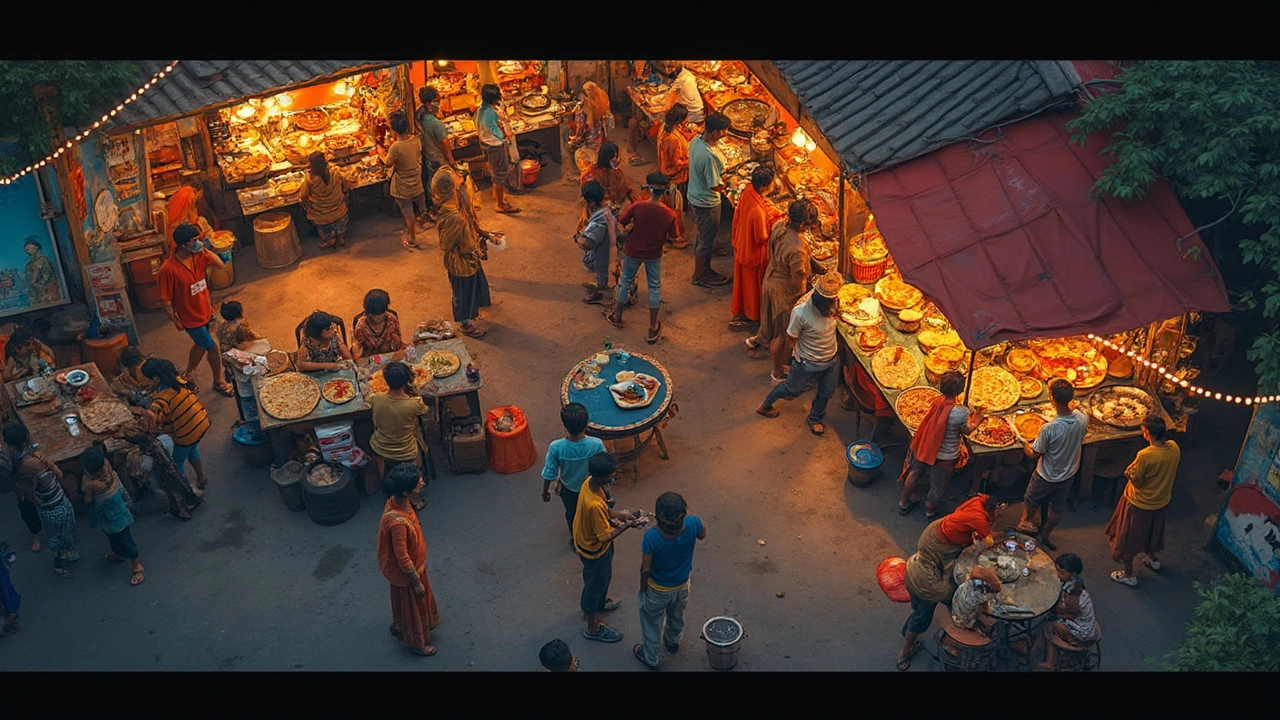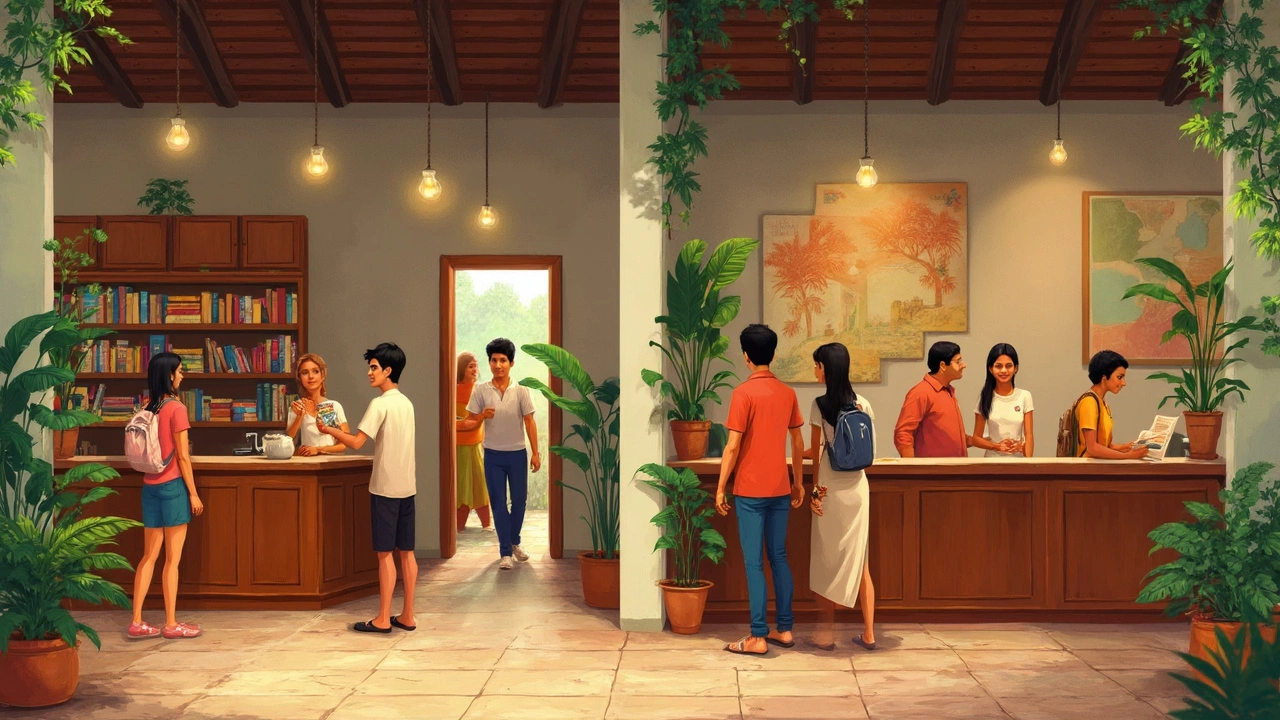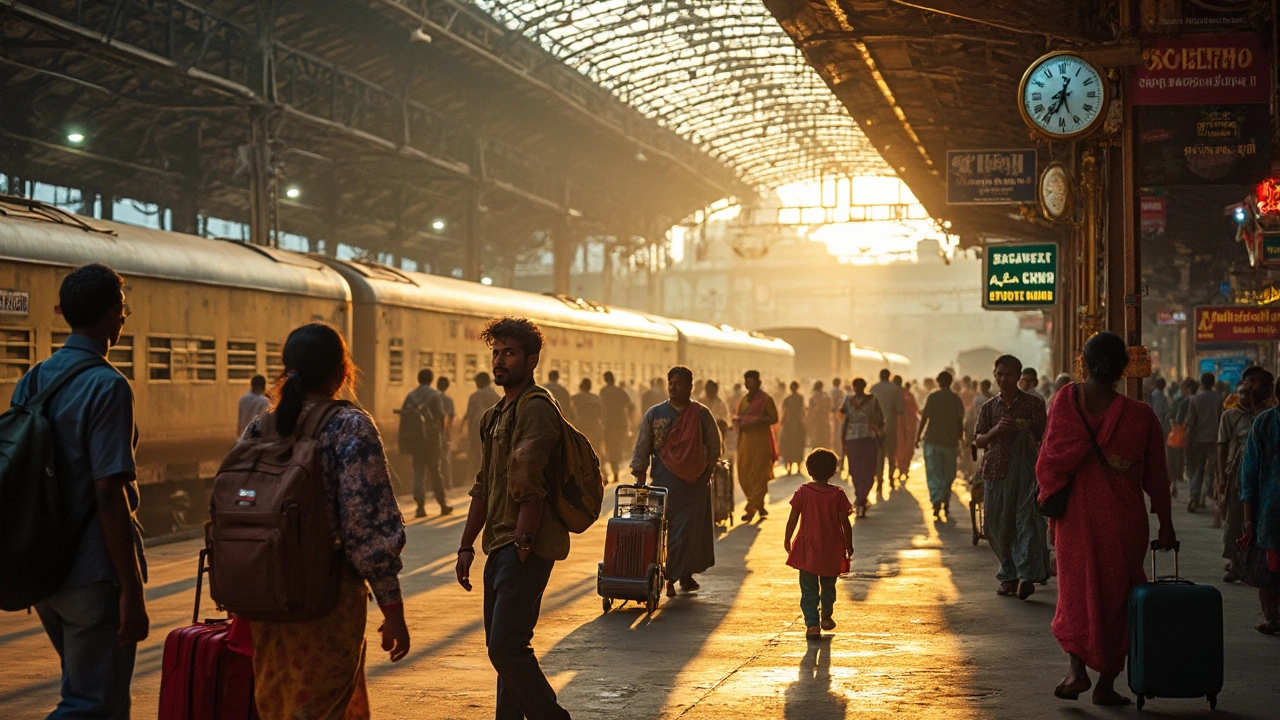Trying to figure out what you'll actually spend on a South India trip? It's not as simple as looking up hotel prices or flight deals. The real cost depends on where you go, how you get around, and even when you book your tickets. Trust me, no one wants their adventure ruined by surprise ATM fees or last-minute price hikes—I've been there, and it's not fun.
Start by looking at your travel style. Are you happy catching sleeper trains and eating at local canteens, or are you more into private cabs and comfy resort rooms? South India has options for every comfort level, and the gap between 'budget' and 'luxury' is wider than you’d expect. A group of travelers I met in Kerala spent less for two weeks than another solo traveler dropped on a three-night spa getaway.
Knowing where your money goes is key. Everything—from local SIM cards to how much cash you’ll need for temples, beaches, street food, and Ubers—adds up. I'll share real numbers and quick hacks so you can spend wisely and enjoy the trip instead of worrying about your budget.
- What Impacts Your South India Trip Cost?
- Travel Styles: Shoestring to Splurge
- Breaking Down the Big Expenses
- Hidden Costs and How to Avoid Them
- Money-Saving Tips from Regular Travelers
What Impacts Your South India Trip Cost?
The price tag for a South India trip cost comes down to way more than just flights and hotels. Here’s the lowdown on what really moves your budget up or down.
- Time of Year: Between December and February (peak tourist season), hotel and train prices shoot up, sometimes doubling over the holidays like Christmas and Pongal. Off-seasons—June to September—mean cheaper rates, but you might hit heavy monsoons.
- Mode of Transport: Direct flights into Chennai or Kochi are usually cheapest if booked in advance. Trains are way cheaper than flights within South India, but you’ll need to grab popular routes weeks ahead, especially sleeper and AC classes. Renting a car with a driver is pricier but makes sense for families or folks who want to skip public transport hassles.
- Where You Sleep: Hostel beds start from as low as ₹400 a night (that’s about $5), while basic hotels go from ₹1000 ($12) and up. High-end resorts in spots like Goa or Kovalam can easily cost over ₹8,000 ($95) per night during high season.
- How You Eat: Eating at local ‘mess’ canteens or street stalls is a steal (meals under ₹100), but international chains or fancy cafes push your daily food spends much higher. Alcohol in tourist hotspots will dig into your budget more than you think, due to state taxes.
- Activities: Temple entry and beach hopping are often free or under ₹50, but guided tours, safaris, spice plantation visits, or Ayurvedic massages can all add up fast.
- Travel Style: Are you all about backpacking, mid-range, or a luxury splurge? Your choices make a huge difference—one person's "cheap trip" could be someone else's big splurge.
Here’s a quick look at some common costs (approximate, per person, in INR and USD as of April 2025):
| Item | Budget | Comfort | Luxury |
|---|---|---|---|
| Accommodation (per night) | ₹400-1000 ($5-12) | ₹2000-4000 ($25-48) | ₹8000+ ($95+) |
| Local meal | ₹80-150 ($1-2) | ₹350-700 ($4-8) | ₹1200+ ($14+) |
| Train (long distance) | ₹250-700 ($3-8) | ₹900-1800 ($10-22) | n/a (fly or private car) |
| Private taxi (per day) | n/a | ₹2200-3200 ($26-38) | ₹6000+ ($72+) |
Little choices like grabbing an extra Uber or eating in a touristy spot can snowball. The key to keeping your South India trip cost reasonable? Decide where you want to splurge, book the essentials ahead, and don’t forget to factor in the occasional unexpected expense. Last year, a last-minute train upgrade nearly doubled my travel costs for one leg—lesson learned!
Travel Styles: Shoestring to Splurge
The cost of a South India trip will swing wildly depending on your style. Let's lay it out—real numbers, no sugarcoating.
Shoestring Travelers: If you’re willing to rough it a bit, you can live on as little as 1,200–1,600 INR (about $15–$20) a day. This means hostel dorms or guesthouse rooms, local buses and trains, and street food that fills you up for under 100 INR a meal. A simple overnight sleeper bus between cities like Bangalore and Kochi can be as cheap as 700 INR ($8). You’ll see backpackers living well on this kind of budget, and honestly, you’ll eat better than you think—South Indian breakfasts are legendary and cheap.
Mid-Range Travelers: Bump your budget to 3,000–6,000 INR ($35–$70) daily, and things get way more comfortable. You’ll get private AC rooms, maybe an inner-city Uber, and the freedom to toss in a guided tour or boat ride without sweating the bill. Domestic flights in South India travel usually start around 2,600–4,000 INR ($30–$50) if you book early, so it’s not a stretch to cover lots of ground on this budget.
Luxury/Splurge Travelers: If you’re up for top-tier hotels, private drivers, and multicourse dinners, expect to spend 10,000–30,000 INR (roughly $120–$350) a day—or a lot more if you go wild in Goa or stay at boutique resorts by the sea. Think Ayurvedic spa treatments, scenic helicopter tours in Kerala, and gourmet meals at heritage hotels. The sky’s the limit if you've got the cash.
| Travel Style | Daily Budget (INR) | Daily Budget (USD) |
|---|---|---|
| Shoestring | 1,200–1,600 | $15–$20 |
| Mid-Range | 3,000–6,000 | $35–$70 |
| Luxury | 10,000–30,000 | $120–$350+ |
The wildest thing? You can adjust your spending as you go. Sleep in a budget room one night, then splurge on a heritage stay the next. With South India, it’s all about mixing things up. Don't forget, train and bus tickets sell out fast in the busy season (December to February), so book as early as possible. Your trip expenses will thank you.

Breaking Down the Big Expenses
If you want a real answer to the question, "How much does a South India trip cost?" you need to know where your money actually goes. I’m talking about the heavy-hitters—flights, stays, getting around, food, and entry fees. Here’s an honest breakdown, without any sugarcoating.
1. Flights
Most travelers coming from outside India will spend the most on flights. If you're flying from Europe or the US, return tickets to Chennai, Kochi, or Bengaluru usually range from $550–$950 depending on the season, according to Skyscanner. Book at least three months early for cheaper deals. Regular domestic flights (used to hop between, say, Kochi and Hyderabad) are actually decent value, averaging ₹3,000–₹6,000 (about $35–$70) if you avoid peak Indian holidays.
2. Accommodation
Your style matters a ton here. Backpacker hostels start at ₹400 ($5) a night. Decent two-star hotels average ₹1500–₹3000 ($18–$36) for a double. Comfortable three- and four-star hotels or nice guesthouses run ₹4000–₹7000 ($50–$85). Resorts and high-end or boutique stays can easily go up to $120–$200 per night, especially in Goa, Pondicherry, or Kerala’s Backwaters.
3. Getting Around
Trains are a classic and usually the cheapest (and sometimes the most fun) way to cover long distances. A second-class sleeper ticket from Chennai to Kochi is about ₹600 ($7), while a faster AC train seat goes for about ₹1700 ($21). Taxis and private cars charge by distance, roughly ₹14–₹18 per km, but always ask for a quote. Domestic buses cost less than ₹300 ($4) for even long rides. Apps like Uber or Ola work in bigger cities, but may cost twice as much as local auto rickshaws for short trips.
4. Food & Drinks
Food is where you can really save or splurge. At local messes or canteens, a meal costs ₹80–₹120 ($1–$1.50). A popular mid-range restaurant meal might run ₹350–₹600 ($4–$7). Drinking alcohol in Kerala or Tamil Nadu can get pricey due to taxes—a 650ml beer is often ₹120–₹200 ($1.50–$2.50) in stores, more in bars. Don’t skip the filter coffee, which is under ₹30 (about $0.40) almost everywhere.
5. Admissions & Experiences
Temples are often free but some famous ones (like Meenakshi in Madurai) charge ₹50–₹250 ($0.60–$3) for special entry. Boat rides on Kerala Backwaters are ₹600–₹1200 ($7–$15) per person for group trips; private houseboats can cost ₹6,000–₹12,000 ($72–$145) per night. National parks and guided trek fees range from ₹300 ($4) up to ₹1200 ($15) for foreigners.
| Expense | Budget / Day (USD) | Mid-Range / Day (USD) | Luxury / Day (USD) |
|---|---|---|---|
| Accommodation | 5–10 | 30–60 | 100+ |
| Food & Drinks | 5 | 15 | 40+ |
| Transport | 4 | 10 | 30+ |
| Activities | 2 | 10 | 30+ |
If you’re on a backpacker budget, ₹1,500–₹2,500 ($18–$30) a day is doable. For mid-range, around ₹4,000–₹7,000 ($50–$85) per person, and luxury can shoot up to ₹15,000 ($180+) fast.
“The beauty of traveling in South India is that you can make it fit your wallet. India rewards both the frugal traveler and the luxury seeker, if you know where to look.” — Lonely Planet India Guide
Keep these numbers handy when you plan. Don’t just estimate based on what your cousin or that random travel blogger says—the gap can be huge depending on how you roll.
Hidden Costs and How to Avoid Them
Lots of people budget for flights and hotels, but then get blindsided by small, sneaky fees that stack up. Here’s what actually grabs your wallet on a South India trip—and how to shut that down before it stings.
- ATM and Bank Charges: Indian ATMs sometimes tack on Rs 200 per withdrawal for foreign cards, and your home bank might hit you with a 2-4% international transaction fee. It’s smarter to take out larger amounts less often. Some international cards—like Revolut or Wise—charge less for INR withdrawals.
- Hotel Taxes and Service Fees: Plenty of hotels quote rates without tax. India’s GST can be up to 18% and gets added at checkout. Check if your booking app shows the final price, not just the base room rate.
- Transport Surcharges: Auto-rickshaws and cabs sometimes pull a “extra night charge” after 10pm, or claim higher festival rates. Ask about the total fare before hopping in, and use Ola or Uber for no-haggle prices.
- Entry Fees and Camera Fees: Most big temples, museums, and sights in South India have two-tier pricing—locals pay less, foreigners pay more. Expect Rs 200–600 for major sites, and extra charges (Rs 50–200) to bring your camera or phone inside.
- SIM Card Costs: A tourist SIM is cheap at official airport kiosks (Rs 500 for a month of data), but in smaller towns, shops sometimes add 'processing' fees or push overpriced plans.
| Hidden Cost | Typical Amount (INR) | How to Avoid or Reduce |
|---|---|---|
| Foreign ATM Fee | 200–300 per transaction | Withdraw larger amounts, use ATM-fee friendly cards |
| Hotel Taxes | 12-18% added at checkout | Book hotels with clear tax-included prices |
| Temple/Museum Entry (Tourist Rate) | 200–600 per site | Research prices beforehand, carry small bills |
| SIM Overcharge | Up to 100% markup | Buy from airport/OFFICIAL outlets |
| Transport Surcharge | 50–200 extra at night | Pre-book cabs or confirm fares before rides |
The best advice? Always check for all-in prices before paying. If someone quotes a price, ask “Does that include all taxes and charges?” If you’re booking on an app, look for a final payment screen that breaks down every fee. And never be shy about asking locals for tips—they’re quick to spot a tourist trap from miles away.

Money-Saving Tips from Regular Travelers
South India doesn’t have to drain your wallet, even if you’re aiming for the South India trip cost on a budget. Over the years, travelers have figured out tricks that make your rupees go a long way—and it’s not just about pinching pennies. Here are tested tips that regulars swear by:
- Book train tickets early: Trains can be dirt cheap, but waiting until the last minute means you’ll end up with only expensive options or, sometimes, nothing at all. Use the IRCTC app or website. Second class is unbelievably affordable, often under ₹500 even for 8-hour journeys.
- Eat like a local: Skip hotel buffets. Instead, hit up ‘meals’ places at lunchtime—these are packed with locals and usually serve unlimited rice, sambar, and sides for around ₹80-₹120. Idlis and dosas for breakfast rarely top ₹50 at street stalls.
- Choose guesthouses over hotels: In places like Hampi, Kochi, and Pondicherry, family-run guesthouses offer clean rooms from ₹500-₹1200 per night, especially if you book in person.
- Use local transport apps: Ola and Uber are all over bigger cities. For shorter trips, auto rickshaws are fine if you ask for the meter. In smaller towns, local buses can cost less than ₹20 for decent distances.
- Resist peak season traps: Prices shoot up from December to February. If you travel just before or after these months, you’ll snag rooms and flights for much less.
- BYO water bottle: Water is cheap, but buying three bottles a day adds up. Most hotels and cafes offer RO water refills for free or ₹10.
Check out this quick breakdown of what travelers usually spend per day for basic expenses:
| Expense | Budget (INR) | Mid-Range (INR) |
|---|---|---|
| Room per night | 600 | 2,000 |
| Meals (per day) | 200 - 350 | 600 - 1,000 |
| Transport (per day) | 100 - 300 | 400 - 1,000 |
Another classic move: visit tourist spots on weekdays. Entry fees are the same, but crowds are much smaller. And don’t forget to bargain—especially at street markets and souvenir stalls. Even my dog Rufus could sniff out when I overpaid for a T-shirt in Mysore.
The real trick is mixing a few splurges with these regular hacks. Maybe book a fancy Kerala houseboat for one night, then stick to homestays and public buses for the rest. This way, you enjoy the best stuff without worrying about your South India travel budget spiraling out of control.
